Allan Armstrong has rewritten the introduction to the first part of his book, From Pre-Brit to Ex-Brit.
In this he takes a closer look at the history of the UK’s Union Flag.
WHAT DOES THE UNION FLAG TELL US ABOUT THE UK?
Today, even the United Kingdom’s most diehard defenders realise their state may not be around forever. This is one of the reasons they are putting up such an intransigent defence. And, as far as the British ruling class goes, their sense of entitlement, following their enrichment over centuries of imperialist plunder and domestic and overseas exploitation, means there are few lengths they will not go to maintain their privileged position, in the face of their continued global decline.
We can get some indication of the current problems facing the British ruling class by examining a key symbol to have emerged in the creation of the United Kingdom of Great Britain and Ireland – the Union Flag or Union Jack. Four core areas have been recognised as forming the foundational basis for the UK state. These developed into what we now term England, Scotland, Wales and Ireland. Yet the official state flag does not represent the UK’s national make up very well.
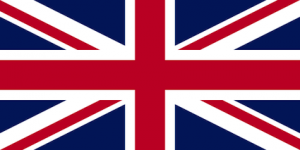
The Union Flag of the United Kingdom of Great Britain and Ireland from 1801, and of the United Kingdom of Great Britain and Northern Ireland from 1921
The Union Flag does recognise England with its St. George’s Cross, and Scotland with its St. Andrew’s Saltire. But Wales, now an officially acknowledged nation within the UK, is not represented with a St. David’s cross. But the Union Flag still has a St. Patrick’s Saltire to represent Ireland, although 26 counties of Ireland are no longer part of the UK.
Therefore, the state’s current official title, the United Kingdom of Great Britain and Northern Ireland, highlights a problem. Great Britain is neither the name of a nation nor of a state. Great Britain was once a geographical term used to distinguish the larger (Celtic) British peopled island from the smaller British peopled peninsula of Little Britain or Brittany. The name Great Britain covers what became England, Wales and Scotland but not Ireland.
After the 1603 Union of the Crowns, under the Stuart dynasty, the term Great Britain represented an historical aspiration to create a united dynastic realm, which included England (incorporating its Welsh principality) and Scotland. This still left Ireland as a semi-detached constituent part of the wider Three Kingdoms, of England, Ireland and Scotland ruled by the Stuarts.
In 1603, James I of England and VI of Scotland pioneered the first Union Flag using the St. George Cross and the St. Andrew’s Saltire. However, the Stuarts’ attempts to create an acceptable Great Britain through dynastic union proved to be premature. The seventeenth and the first half of eighteenth centuries were wracked by conflicts over the future of Great Britain and the Three Kingdoms.
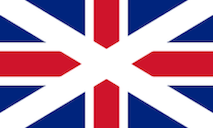
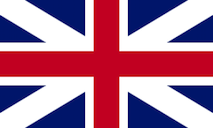
The Union Flags in England and Scotland after the 1603 Union of the Crowns
War commenced between the Stuarts’ Two Kingdoms of Scotland and England in 1639, and was then extended to the Three Kingdoms when Ireland joined in 1641. The monarchy was overthrown as a result of these wars. This occurred first in England in 1649, leading to Cromwell’s republican Commonwealth. Following subsequent wars against Scotland and Ireland, a ‘Greater English’ Republic came to rule over all these islands between 1651-60, first as a Commonwealth then as a Protectorate. This led to two new flags, the first showing the addition of Scotland to England in the Protectorate from 1654, and the addition of Ireland from 1658.

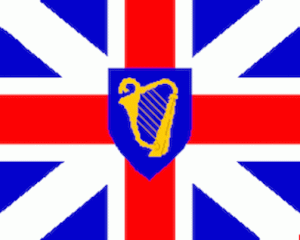
The flags of the Cromwellian Protectorate after 1654 and 1658
The old Union Flags were restored with the return of the Stuart monarchy in 1660, but the UK remained unstable. A new dynasty, headed by William of Orange followed the Glorious Revolution of 1688-91.
After the 1707 Act of Union, a new Union Flag was designed.[1]Scottish Union Flag
But a series of dynastic wars were then fought from 1688 between the House of Orange and the ousted Stuarts; and then from 1715 until 1746 between the House of Hanover and the Jacobites as the Stuart claimants were now called. So, until 1746 there was a possibility that Scotland could have reverted back to the Stuarts’ flags for the Union of the Crowns, if the Jacobites had won out, and retained only the old post-1603 dynastic union.

The Union Flag for the UK after the 1707 Act of Union
After the shock of the 1798 United Irish rebellion, the British ruling class decided to bring Ireland into the Union in 1801. However, Ireland wasn’t brought into Great Britain and remained politically semi-detached. But a new Union Flag was quickly designed, which used the St. Patrick’s Saltire associated with the Anglo-Irish Order of St. Patrick founded in 1783. (Even Cromwell’s Protectorate had acknowledged the Irish harp as Ireland’s national symbol in its the post-1658 flag.)

Union Flag since the 1801 Act of Union
However, in the nineteenth century, the name Great Britain increasingly took on another connotation, with the ‘Great’ representing the projection of British imperial power. Union, Empire and Monarchy were intrinsically linked. The Union Flag appeared in the corner of all the British colonial and later dominion flags.
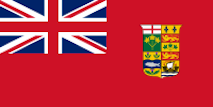
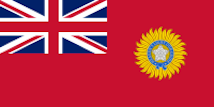
The flags of Canada from 1868-21 and British India from 1880-1947
The first significant reversal for the existence of the United Kingdom, came with the Irish War of Independence, from 1919-21. This was fought to establish the First Irish Republic. This had been declared in the 1916 Easter Rising and was subsequently voted for by a majority in Ireland in the December 1918 Westminster election.
The UK government, though, was able to promote a Civil War from 1922-23, which overthrew the Irish Republic. But this still left 26 of Ireland’s 32 counties counties under the control of the Irish Free State, which was awarded dominion status but now outside the UK. Partition led to only 6 of the Ulster province’s 9 counties remaining under the direct control of the UK state. However, the historically semi-detached status of Ireland was retained for the new statelet of Northern Ireland. This was reinforced by a devolved Stormont, controlled by Unionists with a formidable official armoury of repressive powers, and extra-constitutional Loyalist paramilitary backing.
Following Partition there should have been a new Union Flag. However, the Ulster Unionists did not want to draw too much attention to their new status. They never considered themselves to be an ‘Ulster’ nation. They have remained far happier with seeing their attenuated ‘Ulster’ as being a British province. They made no demand to redesign the Union Flag.
Other provinces/regions like the North East or West Country of England have no specific recognition in the Union Flag. And superimposing say the Red Hand of Ulster on a new Union Flag would not have been a visually attractive proposition, with only 6 of the 9 Ulster counties remaining in Northern Ireland. So, a third of each of the five fingers of the Red Hand would have to have been cut off!
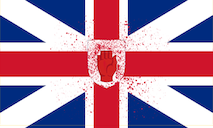
Adding the ‘emblem’ of partitioned Ulster to a post-1921 Union Flag
The Ulster Unionists continued to highlight their role within the UK and their leading role in British imperial wars. Union and Empire have been inextricably linked. Ulster Unionists placed a special emphasis on the recent sacrifices of the Ulster 36th Division at the Battle of the Somme in 1916 – a year with altogether different connotations for Irish Republicans.
But the decision to retain the old Union Flag also reflected the shrinking confidence of the British ruling class. With the defeat of the First Irish Republic, the UK state was able to retain Irish Free State under the Crown. As a British dominion it was given an imperial Governor General, who replaced the previous all-Ireland Lord Lieutenant. And Free State minsters still had to swear an oath of loyalty to the Crown.
However, unlike the other British dominions, the Irish Free State did not have a flag with a Union Jack in its corner. Despite the UK state’s overthrow of the First Irish Republic, the Irish Republican tricolour was retained by the Irish Free State. But this could only now be flown officially in 26 counties of what had been always been been seen as a 32 county nation by Irish Republicans.
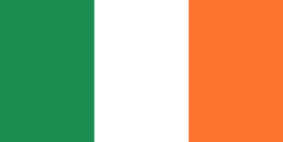
The Irish Tricolour, the flag of the First Irish Republic retained by the attenuated Irish Free State after Partition
The British class realised that, after the First World War, it was much harder for them to dominate the world. This weakness had been underlined by their recent loss of part of the UK state territory in Ireland. Thus, the UK’s unchanged Union Flag became a British ruling class fig leaf to provide some symbolic cover for its declining imperial power. The retention of the whole of the all-Ireland St Patrick saltire in the Union Flag also revealed a lingering British ruling class desire to reassert its domination over the whole of Ireland, highlighted by its overthrow of the First Irish Republic.
The fact that the official Irish state flag did not have a Union Flag component created a precedent for other dominions, as the British Empire began to decline. The Irish Free State, and from 1949 the Republic of Ireland (still only 26 counties) had been able to hang on to this non-union flagged Tricolour due to the impact of the Republicans’ armed resistance to the Union and Empire. But when other dominions won their full independence, or negotiated a further loosening of ties, they too dropped the Union Flag.
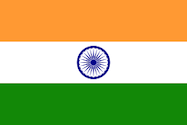

Flags of the Republic of India since 1947 and of Canada since 1965
As the British Empire continued to decline, further new challenges emerged within the Unionist state itself. By far the most significant of these was the renewed Republican struggle within Northern Ireland from the late 1960s, following the UK state’s inability to properly reform its Ulster Unionist and Loyalist Orange sub-state in response to the Civil Rights Movement. After some initial half-hearted attempts at reform, the UK state resorted to widespread repression based on the use of military and other security forces, backed behind-the-scenes by collaboration with extra-constitutional Loyalist militias. And Stormont was abolished in 1972. Although now subject to Direct Rule, Northern Ireland was not brought into Great Britain, like Wales and Scotland. And to maintain the fiction of constitutional normality, the Union Flag remained unchanged
This reactionary unionist clampdown in Northern Ireland was followed by the abandonment of liberal unionist, devolutionary reform in Scotland and Wales in the late 1970s. Despite the undoubted differences in the severity of the unionist clampdown in Northern Ireland, greater demands for national self-determination had gained support in Scotland and Wales too. This eventually led to New Labour’s liberal unionist, ‘Devolution-all-round’ deal in 1997. This recognised a ‘partnership of equals’ for the four (in reality three and a bit) nations within the UK.
With Wales now a fully recognised component nation of the UK, this should have been celebrated with a redesigned Union Flag. However, any change in the Union Flag’s design would once more highlight the ambiguous national make-up of the UK. And in the light of recent national democratic challenges, particularly from the Irish Republican Movement, the UK state’s changing territorial and possibly transient nature would be highlighted. Therefore a new Union Flag incorporating the Welsh St. David’s Cross was not created.
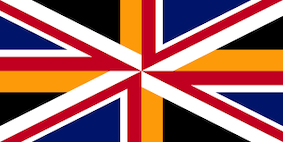
The Union Flag not adopted in 1998 to recognise Wales as a nation of the UK
And under today’s Tory government, both Wales and Scotland are to be reduced to British provinces, under the untrammelled control of the Crown-in-Westminster, backed by the UK state’s anti-democratic Crown Powers. The ‘partnership of equals’ promised by the British ruling class under the post 1997 ‘Devolution-all-round’ deal, is being abandoned. And in the Tories’ Brexit Britain there have even been sections of the British ruling class looking to reassert their socio-economic control over the whole of Ireland.
A British ruling class, in continued global retreat, feels the need to hang on to those older imperial and unionist symbols, every bit as much as those Loyalists do on the Twelfth of July. Hence the continued importance of the Union Jack, which is now flagged up at every possible opportunity. In the absence of an independence referendum, supported in the 2019 Westminster and 2020 Holyrood general elections, the Tory government’s continued promotion of the Union Flag, is making it increasingly appear as a flag of British unionist occupation.
Furthermore, the Union Flag is celebrated not only by the Tories, but by both Liberals and Labour. Indeed, historically, Labour’s highpoint was the ‘Spirit of 45’, social monarchist, unionist, imperialist, welfare state. Today, Sir Keir Starmer does not like the Labour Party to appear in public without the Union Jack. Starmer wants to continue Tony Blair’s British imperial tradition. Blair ordered British troops into combat in five countries, most notoriously in Iraq . Thus it is not surprising that much of the rest of the world, sees the Union Flag as the Butchers’ Apron.
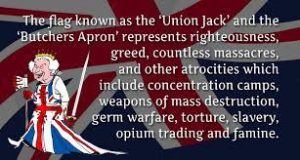
The Union Jack as Butchers’ Apron
The symbolism of the Union Flag, though, has been subjected to change. The traditional conservative bowing and scraping before royal and aristocratic authority and appeals for reverence, which used to underpin the Monarchy and the Union Flag, are now very much on the retreat. Just as the Monarchy has to be made part of the new celebrity culture, so the Union Jack is marketed through a wide range of commercial products, some decidedly tacky.
With neither Monarchy nor Union Flag able to sustain much authority or reverence for ‘Britannia’, Crown or Empire, the promotion of celebrity has helped to disguise the continued political role of the Monarchy in the Union and Empire. In the he UK state, which Monarchy fronts, sovereignty continues to lie with the Crown-in-Westminster. The Crown Powers shield the anti-democratic House of Lords, the Privy Council, the City of London and the heads of the British armed forces, security agencies and civil service from any effective democratic scrutiny.
Thus it can be seen that the official title used to cover the whole state – the United Kingdom of Great Britain and Ireland/Northern Ireland – has been very much tied up with the promotion and defence of a British Empire through its various phases. The failure to redesign the official Union Flag, in 1922 and 1998, puts a spotlight on the UK’s ambiguous and strained relationship between state and nation, the continuing decline of the British Empire, and the consequent increasing fragility of the Union.
also see:- Republican symbolism by Johnnie Gallagher
References
| ↑1 | Scottish Union Flag |
|---|

Some interesting observations. Yet for a state so centred around a dynastic monarchy, the inability to use monarchical symbols as a rallying symbol is also very profound. The unwillingness to use the monarchs’ symbols of the three lions for England and the lion rampant in Scotland suggests an awareness of the latent republicanism within the populations that our ruling classes would not wish to activate. The UK state uses a symbolism that is often in line with an earlier period of history and not in a bourgeois manner associated with monarchy. The need to revert to Roman Catholic, medieval patron saints is very revealing.
Thanks Murdo for your comments. The various saints’ crosses which have been incorporated into the Union Flag (representing England, Scotland and Ireland) or not incorporated (representing Wales) have different histories. The St. George’s and St Andrew’s crosses do have their origins in Roman Catholicism, but were also adopted by the Protestant Churches of England and Scotland. There wasn’t any republican pressure to ditch the royal emblems for England and Scotland in 1603 and the fact that these two crosses were quite acceptable to Protestant England and Scotland under the new Stuart dynasty, meant there was no problem using them in the new Union flags. The St. Patrick’s cross had no such Catholic antecedents but was a creation of the Anglo-Irish elite in the 1780s. However, you would be right in thinking that the spectre of republicanism hung over the 1801 Union flag, so soon after the United Irish rising. The St. David’s/Dewi’s cross was originally only for the St. David’s diocese in Wales, which was also continued from the Roman Catholic to the Protestant Anglican churches (although its territorial extent varied considerably over time). The St. David’s was only tentatively floated as a Welsh flag in the run-up to the 1997 devolution referendum. The red dragon has long been more emblematic of Wales, in a similar way to the harp being emblematic of Ireland.
Another interesting fact is that in 1850 an alternative tricolour was proposed with green, orange and blue vertical stripes. The blue recognised the existence of a separate republican Presbyterian tradition, which had dome much to inspire the United Irishmen However, the 1801 Act of union began a process by which Presbyterianism was absorbed into support for Union, and even the watered down liberal unionism, which had some influence in Belfast had been eclipsed by the 1830s So by 1850, there was no longer an independent Presbyterian republicans, so this could be ignored in the new tricolour dating from 1848. There were still individual Presbyterian and Anglicans who supported an Irish Republic but they identified with the green, which had not been seen in the 1790s as the colour associated with a particular creed, but one uniting Protestant Catholic and and Dissenter.
“In 1850 a flag of green for the Catholics, orange for the Protestants of the Established Church and blue for the Presbyterians was proposed.” (https://web.archive.org/web/20200213202756/https://assets.gov.ie/2949/151118153516-096a94ba6955435cae965414f7667104.pdf).